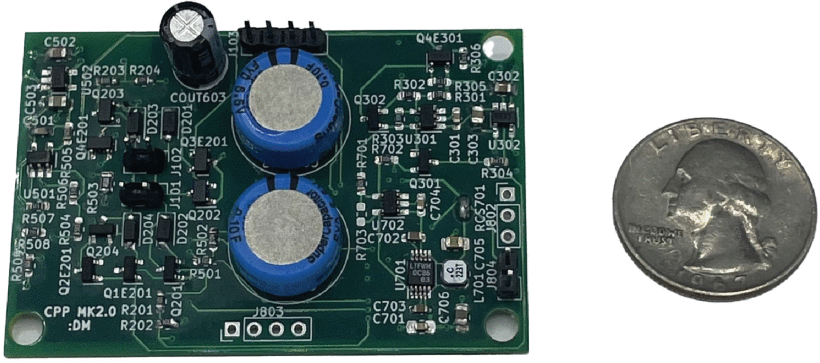Battery-free remote monitoring sensor automatically generates energy from the air
Researchers have unveiled a remarkable battery-free, self-powered sensor capable of harvesting energy from its surrounding environment.

[Jan. 23, 2024: JD Shavit, The Brighter Side of News]
This energy management interface is the "brain" of a self-powered, battery-free sensor that can harvest the energy it needs to operate from the magnetic field generated in the open air around a wire. (CREDIT: MIT)
In a groundbreaking development, researchers at the Massachusetts Institute of Technology (MIT) have unveiled a remarkable battery-free, self-powered sensor capable of harvesting energy from its surrounding environment.
This innovative sensor eliminates the need for recharging or replacing batteries, making it an ideal candidate for placement in hard-to-reach locations, such as within the inner workings of a ship's engine. Here, it can autonomously collect data on the machine's power consumption and operations for extended periods.
The heart of this technological marvel lies in its ability to harness energy from the magnetic field generated in the open air around a wire. Essentially, the sensor can be easily attached to a wire that carries electricity, such as one powering a motor, and it will efficiently harvest and store energy to monitor the motor's temperature.
Steve Leeb, the Emanuel E. Landsman Professor of Electrical Engineering and Computer Science, expressed the significance of this breakthrough, stating, "This is ambient power — energy that I don't have to make a specific, soldered connection to get. And that makes this sensor very easy to install."
Related Stories:
MIT's research in this domain has culminated in a recent paper published as the featured article in the January issue of the IEEE Sensors Journal. In this paper, the team offers a comprehensive design guide for energy-harvesting sensors, enabling engineers to balance the available environmental energy with their specific sensing requirements.
The framework outlined in the paper is incredibly versatile and not limited to sensors that harness magnetic field energy alone; it can be extended to sensors using various power sources, such as vibrations or sunlight. This flexibility opens doors to the creation of cost-effective sensor networks for applications in factories, warehouses, and commercial spaces, making installation and maintenance more accessible and affordable.
Lead author Daniel Monagle, an EECS graduate student, emphasized the practicality of their achievement, stating, "We have provided an example of a battery-less sensor that does something useful, and shown that it is a practically realizable solution. Now others will hopefully use our framework to get the ball rolling to design their own sensors."
Energy harvesters present the exciting opportunity to create sensor nodes that can power or recharge themselves. (CREDIT: IEEE Sensors Journal)
John Donnal, an associate professor of weapons and controls engineering at the U.S. Naval Academy, highlighted the potential impact of such technology in the field of ship systems monitoring. On ships, access to power is often limited, with strict restrictions on what equipment can be plugged in. Donnal explained, "Energy-harvesting systems like this could make it possible to retrofit a wide variety of diagnostic sensors on ships and significantly reduce the overall cost of maintenance."
To achieve this groundbreaking feat, MIT researchers had to overcome three significant challenges.
Firstly, the sensor system needed to cold start, meaning it could initiate its electronics with no initial voltage. This was accomplished through a network of integrated circuits and transistors that allow the system to store energy until it reaches a certain threshold, ensuring that it turns on only when it has accumulated enough power to operate fully.
Secondly, the system had to efficiently store and convert the harvested energy without relying on a battery. A battery would have added complexities and posed potential fire risks. Instead, the researchers incorporated internal energy storage using capacitors.
Capacitors, simpler than batteries, store energy in the electrical field between conductive plates. The capacitors were carefully designed to be large enough to store the necessary energy for startup while being small enough to ensure a quick charge-up phase. They were also designed to retain enough energy, even if some leaked out over time.
High-level system diagram of the self-powered sensor node designed and evaluated in this article. The system is categorized into an equivalent circuit model for the energy harvester, the power electronic and embedded circuitry required for energy management, and a sensor load which includes a dc-dc converter stage. (CREDIT: IEEE Sensors Journal)
Lastly, the researchers developed a series of control algorithms to dynamically measure and budget the energy collected, stored, and used by the sensor. A microcontroller, serving as the "brain" of the energy management interface, constantly monitors energy levels and decides when to turn the sensor on or off, take measurements, or adjust the harvester's output to maximize energy harvesting.
Using this innovative design framework, the team built an energy management circuit for an off-the-shelf temperature sensor. This device harnesses magnetic field energy and continuously samples temperature data, which it then transmits to a smartphone interface via Bluetooth.
Photograph of the top side of the energy management PCB prototype with a United States quarter coin for scale reference. (CREDIT: IEEE Sensors Journal)
The researchers employed super-low-power circuits to design the device but encountered voltage restrictions that could lead to circuit breakdown if too much power were harvested. To mitigate this risk, the energy harvester operating system automatically adjusts or reduces the harvest when excessive energy is detected.
One of the most power-intensive operations for the sensor was data transmission. To address this issue, the researchers are exploring less energy-intensive methods of transmitting data, such as using optics or acoustics. They also aim to develop predictive models to estimate incoming energy and sensor energy requirements more accurately, enabling the sensor to gather even more data.
Jinyeong Moon, an assistant professor of electrical and computer engineering at Florida A&M University-Florida State University College of Engineering, commended MIT's research, stating, "This paper is well-documented regarding what a practical self-powered sensor node should internally entail for realistic scenarios.
The overall design guidelines, particularly on the cold-start issue, are very helpful." Moon believes that engineers planning to design self-powering modules for wireless sensor nodes will benefit greatly from these guidelines.
As engineers and researchers continue to explore and adapt this technology, we can expect to see more innovative solutions that leverage the power of ambient energy to drive progress and efficiency in countless fields.
For more science news stories check out our New Innovations section at The Brighter Side of News.
Note: Materials provided above by The Brighter Side of News. Content may be edited for style and length.
Like these kind of feel good stories? Get the Brighter Side of News' newsletter.



